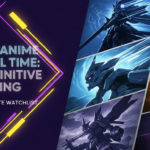In the realm of Japanese pop culture, the debate rages on: “Light Novel vs Manga: Which Is Better?” For those immersed in anime and manga, choosing between these formats can be daunting. Are you struggling to decide which storytelling medium suits your preferences best? Wondering about the nuanced differences and potential advantages of each? Let’s delve into the intricate comparisons to uncover which one might capture your imagination more effectively.
Curious minds, take heed: This exploration isn’t just about picking sides. It’s a deep dive into how these mediums shape narratives and captivate audiences differently. Join me as we dissect the complexities of light novels and manga, uncovering the unique strengths of each. Throughout this article, we’ll unravel the mysteries behind their creation, storytelling techniques, and cultural impacts. Whether you’re a seasoned fan or a curious newcomer, prepare to discover which path through these captivating worlds resonates most with you.
Key Facts:
1. Light novels are primarily text-based with occasional illustrations, while manga relies heavily on visual storytelling.
2. Manga typically has a faster pace and more dynamic action, whereas light novels offer deeper character development and internal monologues.
3. Light novels often provide more detailed world-building and complex narratives compared to manga.
4. Many popular anime series originate from light novels, showcasing their growing influence in the industry.
5. Both mediums have distinct advantages in storytelling, with light novels excelling in descriptive depth and manga in visual expression.
The Essence of Japanese Pop Culture: Light Novels and Manga
Ah, the age-old question that’s been buzzing in otaku circles since time immemorial: light novel vs manga, which is better? As someone who’s spent countless hours lost in both mediums, I can tell you it’s not a simple answer. But fear not, fellow enthusiasts! We’re about to embark on a journey through the intricate world of Japanese storytelling that’ll leave you more informed (and probably more conflicted) than ever before.
Defining the Contenders: What Are Light Novels and Manga?
Before we dive into the nitty-gritty, let’s make sure we’re all on the same page about what we’re comparing.
Light Novels: The Text-Heavy Challenger
Light novels are like the cool, mysterious transfer students of the literary world. They’re not quite full-fledged novels, but they’re definitely more than your average short story. Here’s the lowdown:
- Format: Typically around 50,000 words, peppered with occasional illustrations
- Target Audience: Often aimed at young adults, but don’t let that fool you – they can get pretty complex
- Content: Heavy on dialogue and internal monologues, perfect for those who love to get inside a character’s head
Manga: The Visual Storytelling Veteran
Manga, on the other hand, is the popular kid everyone knows. It’s been around the block and has a massive following. Let’s break it down:
- Format: Sequential art with panels, speech bubbles, and sound effects
- Target Audience: Varies widely, with genres for every age group and interest
- Content: Relies heavily on visual storytelling, with dialogue supporting the action
Now that we’ve got our contestants lined up, let’s see how they stack up against each other in various aspects of storytelling.
The Battle of Formats: Text vs. Visuals
When it comes to format, light novels and manga couldn’t be more different. It’s like comparing apples to… well, comic books.
Light Novels: A Feast for the Imagination
Light novels are the champions of descriptive prose. They paint vivid pictures with words, allowing readers to conjure up their own mental images. This format excels in:
- Detailed world-building: Authors can spend pages describing a single location or concept
- Character depth: Inner thoughts and feelings are explored in great detail
- Complex plots: Multiple storylines can be woven together without visual constraints
Manga: A Visual Extravaganza
Manga, on the other hand, is all about showing rather than telling. Its strengths lie in:
- Dynamic action scenes: A picture is worth a thousand words, especially when it comes to epic battles
- Expressive characters: Facial expressions and body language convey emotions instantly
- Pacing: Panel layouts control the flow of the story, creating tension and excitement

Image caption: A side-by-side comparison highlighting the textual depth of light novels and the visual storytelling of manga.
Storytelling Techniques: The Art of Narrative
Now, let’s get into the meat of the matter – how these mediums actually tell their stories.
Light Novels: The Masters of Introspection
Light novels have a knack for getting you inside a character’s head. They’re like the therapists of the literary world, always asking, “And how does that make you feel?” Here’s what they bring to the table:
- Internal monologues: Characters’ thoughts are laid bare, giving readers deep insights
- Descriptive language: Authors can use flowery prose to set the mood and atmosphere
- Narrative flexibility: Stories can jump between past and present, or even different perspectives, with ease
Manga: The Visual Storytellers
Manga artists are like silent film directors, telling stories primarily through visuals. Their toolkit includes:
- Panel composition: The arrangement of panels can convey passage of time, tension, or emotional impact
- Character design: Unique visual traits help readers instantly recognize and connect with characters
- Sound effects: Onomatopoeias become part of the artwork, adding an auditory dimension to the visual experience
The Cultural Impact: From Japan to the World
Both light novels and manga have left an indelible mark on global pop culture, but in slightly different ways.
Light Novels: The Rising Stars
Light novels are like the indie bands of Japanese media – they’ve got a dedicated following and are starting to hit the mainstream. Here’s their impact:
- Anime adaptations: Many popular anime series started as light novels, like “Sword Art Online” and “The Melancholy of Haruhi Suzumiya”
- Cross-media appeal: Light novels often spawn manga and anime adaptations, creating multimedia franchises
- Global recognition: As more light novels get translated, they’re gaining international fans
Manga: The Global Phenomenon
Manga has been exporting Japanese culture for decades, and its influence is hard to overstate:
- Artistic influence: Manga-style art has inspired creators worldwide
- Industry giant: The manga industry is massive, with titles selling millions of copies globally
- Cultural ambassador: Manga has introduced Japanese culture to readers around the world

Image caption: Contrasting the narrative complexity of light novels with the dynamic visual storytelling of manga.
The Reader’s Experience: Immersion vs. Visualization
Let’s talk about what it feels like to actually sit down with a light novel versus a manga.
Light Novels: A Deep Dive into Words
Reading a light novel is like having a long, intimate conversation with the characters. You get to know them inside and out. Here’s what you can expect:
- Time investment: Light novels generally take longer to read, but offer a more immersive experience
- Imagination workout: Your mind gets to fill in the visual gaps, creating a personalized mental image
- Vocabulary expansion: Exposure to more complex language and writing styles
Manga: A Visual Feast
Flipping through a manga is like watching a movie in slow motion, where you control the pace. The experience includes:
- Quick consumption: Manga can be read faster, making it great for busy schedules
- Visual satisfaction: Artwork can be appreciated on its own merits
- Accessibility: The visual nature makes it easier for some readers to follow complex stories
Adaptations and Cross-Media Success
Both light novels and manga have a track record of successful adaptations, but they approach it differently.
Light Novels: From Page to Screen
Light novels often serve as the source material for anime and manga adaptations. This process has some interesting aspects:
- Creative expansion: Adaptations can visualize scenes only described in text
- Character interpretation: Readers’ imaginations are challenged by concrete visual representations
- Plot condensation: Adapters must decide which parts of the detailed narrative to include
Manga: A Ready Storyboard
Manga adaptations to anime are incredibly common, and for good reason:
- Visual consistency: The manga panels serve as a natural storyboard for animation
- Fan expectations: Readers often have strong opinions about how characters should look and sound
- Pacing challenges: Adapters must decide how to pace the story for a different medium
The Verdict: Is There Really a “Better” Option?
After all this comparison, you might be wondering if we’ve finally cracked the code on which is better: light novels or manga. Well, I hate to break it to you, but there’s no clear winner in this battle. It all comes down to personal preference and what you’re in the mood for.
When Light Novels Shine
Light novels might be your jam if:
- You love getting lost in detailed worlds and complex character thoughts
- You enjoy using your imagination to visualize scenes
- You’re looking for stories with more narrative depth and complexity
When Manga Takes the Cake
Manga might be your go-to if:
- You’re a visual learner who appreciates art as much as story
- You prefer faster-paced narratives with dynamic action
- You enjoy seeing character emotions played out through expressions and body language
The Best of Both Worlds
Here’s a little secret: you don’t have to choose! Many fans enjoy both light novels and manga, often of the same series. It’s like having your cake and eating it too – you get the deep dive of the light novel and the visual punch of the manga.
Some series even benefit from experiencing both versions. You might read the light novel for the intricate plot details and character development, then flip through the manga to see how artists interpret key scenes visually. It’s a win-win situation!
The Future of Light Novels and Manga
As we look to the future, both light novels and manga are evolving. Digital platforms are changing how we consume these media, and global audiences are influencing their creation.
Light Novels: The Digital Revolution
Light novels are finding new life in the digital age:
- E-book popularity: Digital formats make light novels more accessible globally
- Web novel phenomenon: Many light novels start as web novels, blurring the lines between amateur and professional writing
- Interactive elements: Some digital light novels incorporate choice-based narratives or multimedia elements
Manga: Adapting to the Digital Age
Manga is also embracing technology:
- Webtoons: Vertical-scrolling digital comics are gaining popularity
- Global creation: Non-Japanese creators are entering the manga market, bringing diverse perspectives
- Augmented reality: Some manga are experimenting with AR features for enhanced reading experiences
As both mediums continue to evolve, the line between them may blur even further. Who knows? We might see hybrid formats that combine the best of both worlds!
FAQs About light novel vs manga which is better?
Q: What is the main difference between light novels and manga?
A: The main difference between light novels and manga is their format and storytelling approach. Light novels are primarily text-based with occasional illustrations, focusing on detailed narratives and character thoughts. Manga, on the other hand, relies heavily on sequential art and visual storytelling, using panels and illustrations to convey the story.
Q: Are light novels more detailed than manga?
A: Yes, light novels are generally more detailed than manga in terms of narrative description and character introspection. Light novels can dedicate pages to describing settings, character thoughts, and complex plot points, while manga relies more on visual cues and dialogue to convey information.
Q: Which is better for action scenes, light novels or manga?
A: Manga is typically considered better for action scenes due to its visual nature. Manga artists can create dynamic, detailed illustrations of action sequences that can be instantly understood and appreciated. Light novels describe action through text, which can be vivid but may not have the same immediate impact as visual representations.
Q: Do light novels or manga take longer to consume?
A: Light novels generally take longer to consume than manga. Reading a light novel involves processing more text and imagining scenes, which can be time-consuming. Manga, with its visual storytelling, can often be read more quickly, although readers may spend additional time appreciating the artwork.
Q: Can I enjoy both light novels and manga of the same series?
A: Absolutely! Many fans enjoy both light novels and manga of the same series. This allows them to experience the story in different ways – getting detailed narrative and character insights from the light novel, and visual interpretations of key scenes from the manga. Some find that consuming both enhances their overall enjoyment of the series.
Summary
In our exploration of “light novel vs manga which is better?”, we’ve uncovered the unique strengths and characteristics of both mediums. Light novels excel in providing detailed narratives, complex character development, and intricate world-building through text, allowing readers to dive deep into the story’s intricacies. Manga, on the other hand, shines with its visual storytelling, dynamic action scenes, and ability to convey emotions and atmosphere through artwork.
The truth is, there’s no definitive answer to which is better – it all comes down to personal preference and what you’re seeking in your reading experience. Both light novels and manga have their place in the rich tapestry of Japanese pop culture, each offering a unique way to engage with stories and characters.
As we’ve seen, many fans enjoy both mediums, often for the same series, appreciating the complementary experiences they provide. So, rather than choosing one over the other, why not embrace both? Explore the detailed worlds of light novels and the visual excitement of manga. Your next favorite story might be waiting in either format, ready to transport you to new and exciting realms of imagination.



